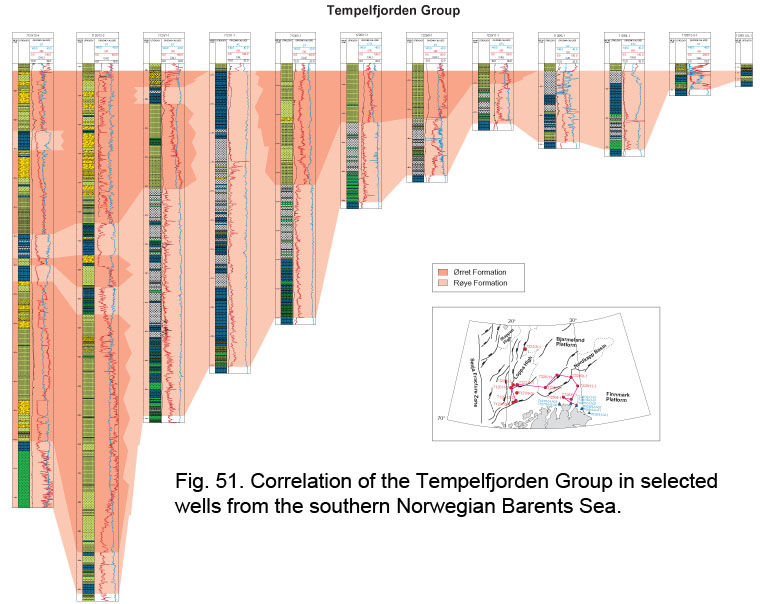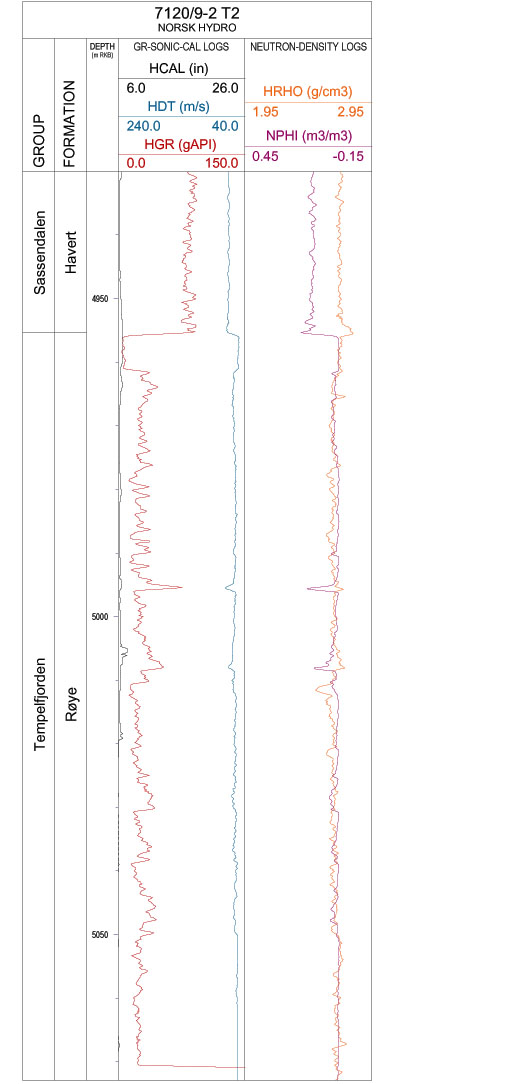Tempelfjorden Group (Tempelfjordgruppen)
Formations assigned to the group
Name:
Cutbill & Challinor (1965) introduced the term Tempelfjorden Group for a suite of spiculites, spiculitic chert, silicified limestones and fine-grained siliciclastics of mid- to late Permian age. The type area is in the innermost part of Isfjorden in central Spitsbergen. The Tempelfjorden Group is a well-established lithostratigraphic unit; its overall facies development and depositional evolution have been described by Steel & Worsley (1984) and Ezaki et al. (1994).
Offshore reference areas:
The southern Loppa High – Hammerfest Basin, the Bjarmeland Platform and the eastern Finnmark Platform illustrate the quite significant variations in the group’s development offshore (Fig. 51). The group is thickly developed along the southern margins of the Loppa High where it has been penetrated by wells 7121/1-1 and 7120/1-1. The upper parts of the group were penetrated by 7120/9-2 (from 4956 m to TD at 5072.6 m, Fig. 52) in the central Hammerfest Basin, while thickest – but sedimentologically atypical - developments are seen in wells 7120/12-2 (4558-3657 m) and 7120/12-4 (2118-1366 m) on the basin’s southern margins (Fig. 51).

Fig. 52. Well logs of the upper part of the Tempelfjorden Group in 7120/9-2 from the Hammerfest Basin showing the junction to the Triassic Havert Formation.

Thickness:
The group thickens from 509 m in well 7121/1-1 and 591 m in well 7120/1-1 on the southern Loppa High, to 752 m in well 7120/12-4 and 901 m in well 7120/12-2 along the southern margins of the Hammerfest Basin (Fig. 51). This is appreciably thicker than the maximum of 460 m observed on land areas of Svalbard. Thinner developments are seen eastwards on the Bjarmeland Platform - 425 m in well 7124/3-1 and 226 m in well 7226/11-1 along the southern margins of the platform. On the eastern Finnmark Platform it forms a distinctive wedge-shaped unit thinning from approximately 180 m in well 7228/9-1 (Fig. 51) on the northern shelf margins to 135 m in wells 7128/4-1 and 7128/6-1 and to less than 30 m further updip in the subcrop areas demonstrated by IKU shallow cores.
The Tempelfjorden Group usually thins over local structural highs - exposures on BjГёrnГёya on the Stappen High show an extremely condensed (115 m thick) development of the group and highly condensed exposures on the margins of the SГёrkapp-Hornsund High are only a few metres thick, thinning to zero over the crest of the structure (Hellem & Worsley 1978). It is not certain whether the group was initially deposited over the crest of the Loppa High, but the succession also thins and is then truncated upflank there, reflecting repeated uplift in the Permian to early Triassic; a roughly similar situation is seen in the inner parts of the Finnmark Platform, although thinning there reflects maximum onlap of the adjacent craton rather than active tectonism.
Lithology:
The Tempelfjorden Group is characterised by dark to light grey spiculites, spiculitic cherts, silicified skeletal limestones and fine-grained siliciclastics including marls, calcareous claystones, shales and silt/sandstones in the offshore areas. In the southwestern Hammerfest Basin (7120/12-4 and 7120/12-2) the group contains a significant proportion of coarse siliciclastics. Elsewhere in the Norwegian Barents Sea, spiculites and silicified skeletal carbonates dominate. The carbonates contain a fauna dominated by brachiopods, sponges, bryozoans and crinoids. The condensed development of the Miseryfjellet Formation on the Stappen High contains herringbone cross-bedded sandstones and highly condensed silicified skeletal limestones.
Lateral extent and variation:
The group is thickest in the western part of the study area. It forms distinctive wedgeshaped units with maximum thickness in the basins. On the eastern Finnmark Platform, the lower part of the group onlaps the inner Finnmark Platform and subcrops the Quaternary further updip. Lithologies are uniform in the eastern part of the study area and are dominated by chert and chert-rich limestone, while coarse siliciclastic domination in the southern Hammerfest Basin suggests emergent local provenance areas.
The boundary between the Gipsdalen Group and the underlying Billefjorden Group is only known with certainty from wells 7128/4-1 and 7128/6-1 on the Finnmark Platform and from 7120/2-1 on the Loppa High. On the Finnmark Platform, the sharp contact between Lower Carboniferous grey fluvial siliciclastics with coals below and red bed facies with caliche above marks a boundary represented by a major regional unconformity in the circum-Arctic and is associated with a significant change in palaeoclimate from warm and humid to warm and arid to semi-arid (Steel & Worsley 1984; Stemmerik & Worsley 1989; Stemmerik 2000).
Sediments assigned to the Tempelfjorden Group generally overlie the Bjarmeland Group (except in wells 7120/12-2 and 7120/12-4 where they directly overlie the Gipsdalen Group). There is a sharp contact between Artinskian light grey, skeletal limestones below and the overlying dark-grey to black, silicified and spiculitic fine-grained deposits. The boundary represents a major drowning event in the Barents Sea region, and an ongoing change towards cooler climatic conditions (Stemmerik 1997).
Age:
The Tempelfjorden Group is dated as late Artinskian to ?Tatarian in the onshore areas (Nakrem 1991; Mangerud 1994). Palynological data from cores 7128/12-U-01 and 7129/10-U-01 indicate a ?Kungurian to Kazanian (-?Tatarian) age for the group updip on the Finnmark Platform (Mangerud 1994; Bugge et al. 1995). Palynomorphs from exploration wells indicate a general mid- to late Permian age for the group without permitting a more detailed internal zonation.
Depositional environments:
The Tempelfjorden Group represents deposition in cool-water, temperate shelf and basinal environments. The majority of the group was deposited in distal marine, low-energy (below wave base), moderate to deep shelf to basinal environments characterised by a rich siliceous sponge fauna. The group was deposited during an overall transgression accompanied by retrogradation of the coastline. The main accumulations of spiculites appear to be related to transgressive periods when favourable environmental conditions for sponges prevailed over most of the shelf. Cool-water, bryozoan carbonates formed along the margins and formed low-relief platforms during sea level highstand.
Wells in the southernmost Hammerfest Basin are characterised by significant coarse siliciclastic influx from the nearby Baltic Shield.
Formations assigned to the group:
Two new formations are assigned to the Tempelfjorden Group herein: their names are selected from fish common to the Barents Sea. The generally underlying RГёye Formation is characterised by generally fine-grained highly silicified mudstones and limestones, while the generally overlying Г
